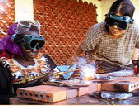
Mama Wahunzi 2002
Distributed by Women Make Movies, 462 Broadway, New York, NY 10013; 212-925-0606
Produced by Lawan Jerasuradej
Directed by Lawan Jerasuradej
VHS, color, 57 min.
Jr. High - Adult
African Studies, Women's Studies, Disability Studies
Date Entered: 11/09/2018
Reviewed by Kayo Denda, Rutgers UniversityThe everyday challenges experienced by wheelchair bound individuals are enormous, especially when they live in Uganda and Kenya. Tolerance for the disabled, proper wheelchairs, and physical infrastructure such as curb cuts and paved streets are scarce, practically absent. In both countries, there are only 5 production shops where 250 wheelchairs are built annually for the 100,000 people who need them. At that, only 1% of the wheelchairs are given to women. “Mama Wahunzi,” meaning “women blacksmiths” in Swahili, focuses on the trajectory of three wheelchair bound East African women who succeed in learning to manufacture a wheelchairs in a workshop sponsored by “Whirlwind Women, the International Women’s Wheelchair Building Project,” affiliated with “Whirlwind Wheelchair International” at San Francisco State University. Later, the women open independent wheelchair production shops that fill local needs and bring financial stability in their lives.
This cultural documentary, by the award winning women filmmaker Lawan Jerasuradej from Thailand, presents many faces of East Africa: the energetic cityscapes of Kampala, the groupings of people in the villages, and the colorful clothing and music of both. The three women featured have in common their disabilities and a life of overcoming adversity. Sharifa is a polio survivor who has to fight constantly with taxi-drivers who want to charge her twice the fare to pick her up. Fatuma, a mother of six children, has had to migrate several times to avoid wars in Uganda. Peninah was sterilized without her consent after the birth of her child. Despite many years of schooling and professional expertise, rampant stereotyping and lack of mobility prevent these women from finding steady employment. They make their living engaged in poorly remunerated home bound activities such as weaving cloth and making baskets, often assisted by family members, including their husbands and children.
The metal workshop scenes are vivid and effectively capture the excitement of the participants who gradually succeed in learning to build a wheelchair from material available locally. The American instructors include disability rights advocates, engineers, an architect and a medical technologist, and they teach the participants how to bend and to cut the metal parts to build a wheelchair. Later, the instructors teach the participants techniques of how to maneuver the new wheelchair efficiently. The women’s courage, perseverance and the ultimate empowerment has a spiritual quality fitting for outreach to the disabled everywhere, especially those in impoverished areas.
Poor sound quality makes the interviews with the three women and their families sometimes difficult to understand. Well designed titles that summarize the narrative address this need to some extent, but the lack of subtitles for the non-English dialog prevents the viewer access the many spontaneous local voices expressing their perception on the issues of the disabled. Yet the film brings visibility to the overall difficulties and rights of the disabled women not only in this region but all over the world. Some scenes, such as the one at the Nairobi Wild Game Park, diminish the activist nature of the film, effectively sugar-coating the social conditions, and not reflecting the seriousness of the issues faced by the African women with disabilities.